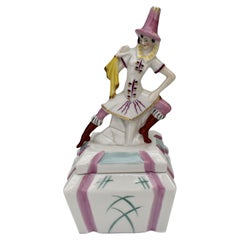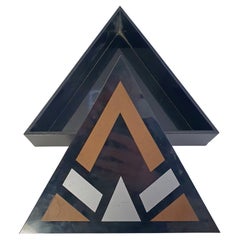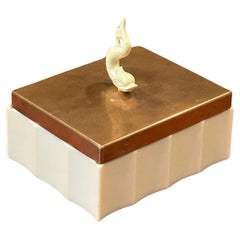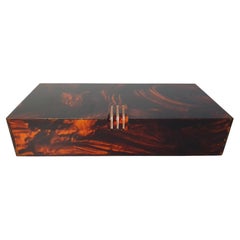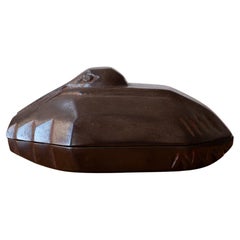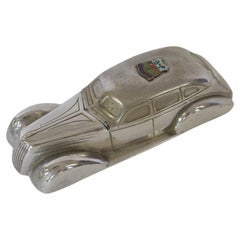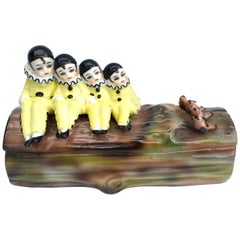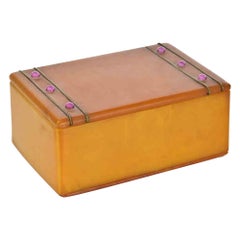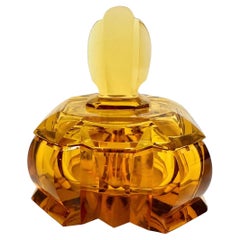Art Deco Trinket Box
Mid-20th Century German Art Deco Ceramics
Porcelain
20th Century Italian Art Deco Decorative Boxes
Lucite, Plexiglass
Early 20th Century American Art Deco Bookends
Copper
20th Century Italian Art Deco Decorative Boxes
Lucite, Plexiglass
Vintage 1930s Japanese Art Deco Decorative Boxes
Bronze
Vintage 1930s French Art Deco Decorative Boxes
Chrome
Mid-20th Century French Art Deco Decorative Boxes
Porcelain
Vintage 1930s European Decorative Boxes
Bakelite
Vintage 1930s Austrian Art Deco Decorative Boxes
Art Glass
Vintage 1930s Austrian Art Deco Decorative Boxes
Art Glass
Mid-20th Century Art Deco Decorative Boxes
Mahogany
Vintage 1930s Jewelry Boxes
Malachite
Vintage 1920s Art Deco Decorative Boxes
Glass
Mid-20th Century Chinese Decorative Boxes
Other
Vintage 1920s Chinese Art Deco Jewelry Boxes
Metal
Vintage 1930s Art Deco Decorative Boxes
Ceramic
Early 20th Century English Art Deco Decorative Boxes
Silver, Sterling Silver
Mid-20th Century Unknown Jewelry Boxes
Hardwood
Vintage 1930s Danish Art Deco Jewelry Boxes
Bronze
Vintage 1920s French Art Deco Decorative Boxes
Porcelain
20th Century European Art Deco Decorative Boxes
Malachite
20th Century European Art Deco Decorative Boxes
Malachite
21st Century and Contemporary French Art Deco Decorative Boxes
Brass
Early 20th Century English Art Deco Decorative Boxes
Shagreen, Wood
Vintage 1960s German Art Deco Jewelry Boxes
Brass
Mid-20th Century English Art Deco Decorative Boxes
Porcelain
Mid-20th Century European Art Deco Jars
Porcelain
Vintage 1940s American Folk Art Aviation Objects
Wood
Vintage 1930s Czech Art Deco Animal Sculptures
Glass, Slag Glass
Vintage 1930s Austrian Art Deco Glass
Art Glass
Mid-20th Century French Art Deco Figurative Sculptures
Ceramic
Mid-20th Century European Art Deco Jars
Porcelain
Mid-20th Century French Art Deco Figurative Sculptures
Ceramic
20th Century Italian Art Deco Decorative Dishes and Vide-Poche
Alabaster
Mid-20th Century French Art Deco Jars
Ceramic
Mid-20th Century German Art Deco Jars
Ceramic
Mid-20th Century German Art Deco Jars
Porcelain
Mid-20th Century German Art Deco Jars
Ceramic
Vintage 1930s American Art Deco More Desk Accessories
Nickel
Vintage 1930s English Art Deco Decorative Boxes
Shagreen
Late 20th Century Philippine Art Deco Decorative Boxes
Marble, Brass
Vintage 1920s Canadian Art Deco Aviation Objects
Bronze
Vintage 1960s Congolese Art Deco Vases
Malachite
Early 20th Century European Art Deco Decorative Boxes
Wood
Vintage 1930s Art Deco Decorative Boxes
Metal
Mid-20th Century German Art Deco Ceramics
Porcelain
Early 20th Century American Art Deco Bookends
Copper
Mid-20th Century English Art Deco Decorative Boxes
Ceramic
Vintage 1930s English Jewelry Boxes
Sterling Silver
Mid-20th Century German Art Deco Decorative Boxes
Porcelain
Mid-20th Century German Art Deco Decorative Boxes
Ceramic
Vintage 1930s French Art Deco Jewelry Boxes
20th Century Decorative Boxes
Glass
Early 20th Century Art Deco Decorative Boxes
Malachite, Brass
Early 20th Century Italian Art Deco Decorative Boxes
Metal
Early 20th Century French Art Deco Jewelry Boxes
Porcelain
Mid-20th Century German Art Deco Ceramics
Ceramic
20th Century Italian Arts and Crafts Decorative Boxes
Metal
- 1
Art Deco Trinket Box For Sale on 1stDibs
How Much is a Art Deco Trinket Box?
A Close Look at Art Deco Furniture
Art Deco furniture is characterized by its celebration of modern life. More than its emphasis on natural wood grains and focus on traditional craftsmanship, vintage Art Deco dining chairs, tables, desks, cabinets and other furniture — which typically refers to pieces produced during the 1920s and 1930s — is an ode to the glamour of the “Roaring Twenties.”
ORIGINS OF ART DECO FURNITURE DESIGN
- Emerged in the 1920s
- Flourished while the popularity of Art Nouveau declined
- Term derives from 1925’s Exposition Internationale des Arts Décoratifs et Industriels Modernes (International Exhibition of Modern Decorative and Industrial Arts) in Paris, France
- Informed by Ancient Egypt, Cubism, Futurism, Louis XVI, De Stijl, modernism and the Vienna Secession; influenced Streamline Moderne and mid-century modernism
CHARACTERISTICS OF ART DECO FURNITURE DESIGN
- Bold geometric lines and forms, floral motifs
- Use of expensive materials such as shagreen or marble as well as exotic woods such as mahogany, ebony and zebra wood
- Metal accents, shimmering mirrored finishes
- Embellishments made from exotic animal hides, inlays of mother-of-pearl or ivory
ART DECO FURNITURE DESIGNERS TO KNOW
VINTAGE ART DECO FURNITURE ON 1STDIBS
Few design styles are as universally recognized and appreciated as Art Deco. The term alone conjures visions of the Roaring Twenties, Machine Age metropolises, vast ocean liners, sleek typography and Prohibition-era hedonism. The iconic movement made an indelible mark on all fields of design throughout the 1920s and ’30s, celebrating society’s growing industrialization with refined elegance and stunning craftsmanship.
Widely known designers associated with the Art Deco style include Émile-Jacques Ruhlmann, Eileen Gray, Maurice Dufrêne, Paul Follot and Jules Leleu.
The term Art Deco derives from the name of a large decorative arts exhibition held in Paris in 1925. “Art Deco design” is often used broadly, to describe the work of creators in associated or ancillary styles. This is particularly true of American Art Deco, which is also called Streamline Moderne or Machine Age design. (Streamline Moderne, sometimes known as Art Moderne, was a phenomenon largely of the 1930s, post–Art Nouveau.)
Art Deco textile designers employed dazzling floral motifs and vivid colors, and while Art Deco furniture makers respected the dark woods and modern metals with which they worked, they frequently incorporated decorative embellishments such as exotic animal hides as well as veneers in their seating, case pieces, living room sets and bedroom furniture.
From mother-of-pearl inlaid vitrines to chrome aviator chairs, bold and inventive works in the Art Deco style include chaise longues (also known as chaise lounges) and curved armchairs. Today, the style is still favored by interior designers looking to infuse a home with an air of luxury and sophistication.
The vintage Art Deco furniture for sale on 1stDibs includes dressers, coffee tables, decorative objects and more.
Finding the Right Boxes for You
From mere trinkets to useful receptacles that serve a distinct purpose, antique boxes as decorative objects have come in many forms over the years. No matter what they’re made of or where they end up in your home, decorative boxes add both style and storage to your space.
The decorative box that is likely most common is the jewelry box. These boxes were originally known as jewel caskets and were in common use in Ancient Egypt, as most Egyptians wore some sort of jewelry. A portable jewelry box, in its original intended use, was integral to keeping your jewelry safe and secure. This accessory has transformed in size, shape and appearance over the years. Initially it was common for a jewelry box to bear intricate ornamentation. Whether they’re mid-century modern works of marble and brass or feature playful Art Deco–style geometric decor, jewelry boxes boast real staying power.
Snuff boxes began to soar in popularity during the 17th century (and were commonplace in European homes by the mid-19th century). The boxes, some hand-painted with landscape scenes, some made from gold, porcelain or stone, contained a small amount of tobacco, which users would sniff, or “snuff,” throughout the day. Some particularly ornamental snuff boxes featured enameled designs or were set with precious gems and were given as gifts or party favors, particularly at the coronation of royalty or other lavish events.
Whether you’re organizing important mail in the foyer or tucking away medications in your bathroom, antique boxes — be they metal tea caddies, sterling-silver decorative boxes or Victorian cigar boxes made of oak (even if you don’t smoke) — are a sophisticated solution to help keep the surfaces in your home clutter-free. And no matter if you’re seeking a decorative box to beautify a desktop or bestow upon a loved one, you are sure to find something you love in the collection of antique and vintage boxes on 1stDibs.
